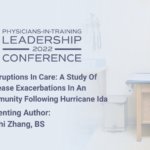Abstract | April 5, 2022
Addressing Disruptions In Care: A Study Of Chronic Disease Exacerbations In An Underserved Community Following Hurricane Ida
Learning Objectives
- Understand how natural disasters impact healthcare delivery to underserved communities.
Medically underserved communities have a higher prevalence of chronic diseases compared to the general population and are more vulnerable during disruptions of care following natural disasters. The compounding of lifelong socioeconomic pressures, chronic health burden, and acute mental and physical stress can all factor into poorer health outcomes, which calls for systemic attention, intervention, and prevention.
This is a retrospective review of patients from an underserved community in New Orleans seen at a primary care clinic over a one-month period following hurricane Ida’s landfall in August 2021. Patient demographics, medical history, vitals, and lab values were collected. Patient reports of disruptions in care were recorded.
In the month following hurricane Ida, a total of 237 patients were scheduled for visits, of which only 148(62.4%) presented to clinic (56.8% male, mean age=50.9 years, 51.4% African American [AA]). The prevalence of hypertension(HTN), diabetes(DM), and chronic kidney disease(CKD) were 56.8%, 18.4%, and 14% respectively. Newly collected vitals and labs were used to compared against patients’ prestorm baselines. Notably, mean systolic BP increased by 7.4mmHg in those with HTN, hemoglobin A1c increased by 0.32% in those with DM, and creatinine increased by 0.14 mg/dL in those with CKD (all p<0.001). Based on clinical notes, 18.4% of all patients reported gaps in medication access; 34.2% reported experiencing delays/cancellations of care; 52.6% reported significant displacement-induced stresses. To provide adequate context, two representative cases are described below: A 36-year-old AA man with DM presented with an A1c of 13%, up from 6.5% three-months pre-storm. He reports running out of insulin and metformin, unable to refill due to citywide pharmacy closures, stress eating, poor sleep, and extreme fatigue.
A 72-year-old AA man with obstructive sleep apnea had a well-controlled BP of 128/74 on CPAP at baseline. During evacuation, his CPAP was damaged. At presentation one-month post-storm, he reported restless sleep with BP of 160s/70s repeated on both arms. He was still awaiting CPAP replacement.
Underserved communities are at higher risk for complications of chronic health diseases due to healthcare disruptions following natural disasters. Systemic awareness, education, and anticipatory action are needed to improve health disparities in vulnerable populations.

